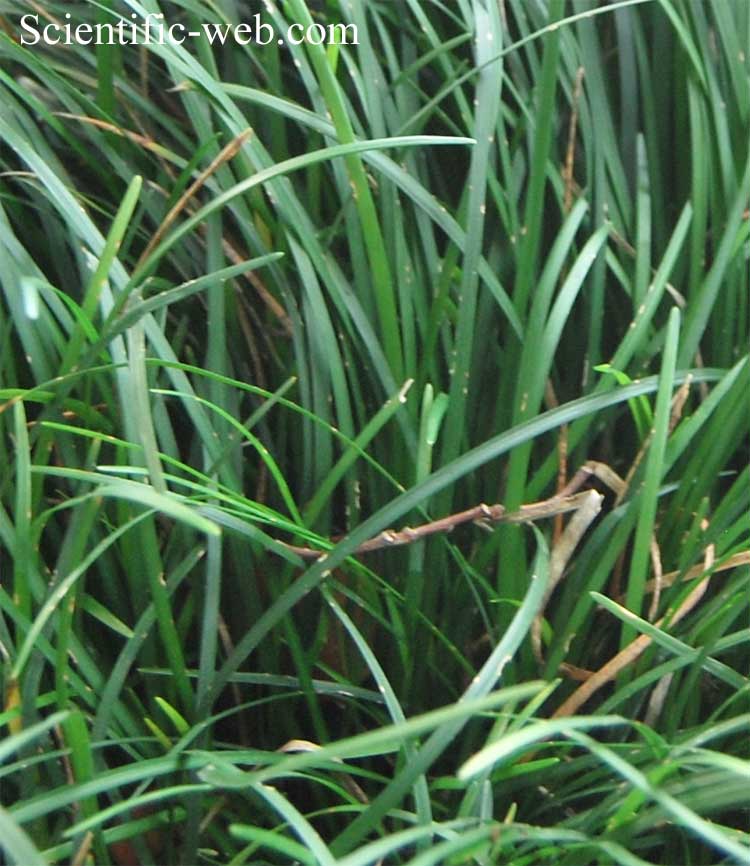
Ophiopogon japonicus, Photo: Michael Lahanas
Classification System: APG IV
Superregnum: Eukaryota
Regnum: Plantae
Cladus: Angiosperms
Cladus: Monocots
Ordo: Asparagales
Familia: Asparagaceae
Subfamilia: Nolinoideae
Tribus: Ophiopogoneae
Genus: Ophiopogon
Species: Ophiopogon japonicus
Name
Ophiopogon japonicus (Thunb.) Ker Gawl.
References
Botanical Magazine; or, Flower-Garden Displayed ... London 27: t. 1063. 1807
USDA, ARS, Germplasm Resources Information Network. Ophiopogon japonicus in the Germplasm Resources Information Network (GRIN), U.S. Department of Agriculture Agricultural Research Service. Accessed: 07-Oct-06.
Ophiopogon japonicus (dwarf lilyturf,[1] mondograss, fountainplant, monkeygrass; Japanese: リュウノヒゲ ryu-no-hige ("dragon's beard") or ジャノヒゲ ja-no-hige ("snake's beard") is a species of Ophiopogon native to China, India, Japan, and Vietnam.
Description
It is an evergreen, sod-forming perennial plant. The leaves are linear, 20–40 cm long. The flowers are white through pale lilac, borne in a short raceme on a 5- to 1-cm stem. The fruit is a blue berry, 5 mm in diameter.[2] Underground, this species has large stolons with tuberous roots.[3]
Cultivation
It is grown as an ornamental plant, providing excellent groundcover. Several cultivars have been selected, including 'Albus' (white flowers), 'Compactus' and 'Kyoto Dwarf' (dwarf forms, not over 4–5 cm tall), and 'Silver Mist' (variegated, with white-striped leaves). It is often sold as a decorative plant for freshwater aquaria, but because it is not a true aquatic plant, it can live for a few months underwater before it dies. While hardy to temperatures of about – 20°C when dormant in winter outdoors in normal soil, when kept fully submerged, it requires water temperatures of 18–25°C. It grows well in full sun or partial shade. Propagation is from side shoots.[2][4]
Traditional uses
In traditional Chinese medicine, both O. japonicus plants and tubers are known as mai men dong (Chinese: 麥門冬). Tubers are used as the cardinal herb for yin deficiency. According to the "Chinese Herbal Medicine Materia Medica", the herb is sweet, slightly bitter, and slightly cold; enters the heart, lung, and stomach channels; nourishes the yin of the stomach, spleen, heart, and lungs; and clears heat and quiets irritability. Liriope spicata is used as a substitute.[5]
References
"Ophiopogon japonicus". Natural Resources Conservation Service PLANTS Database. USDA. Retrieved 23 July 2015.
Huxley, A., ed. (1992). New RHS Dictionary of Gardening. Macmillan ISBN 0-333-47494-5.
Brown, D., (1995) "The Royal Horticultural Society encyclopedia of herbs and their uses". ISBN 1-4053-0059-0
Hiscock, P. (2003). Encyclopedia of Aquarium Plants. Interpret Press.
Chinese Herbal Medicine Materia Medica Third Edition by Daniel Bensky, Steven Clavey, Erich Stoger and Andrew Gamble. Eastland Press, 2004
Retrieved from "http://en.wikipedia.org/"
All text is available under the terms of the GNU Free Documentation License

